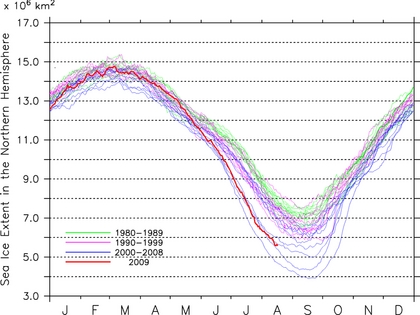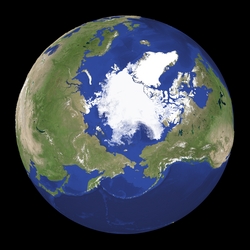2009.08.18
GIC Weekly Report for the Arctic Region Vol.3
Ice remains at Taimyr peninsula
Topic of the Week
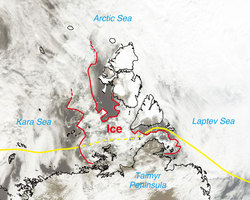
Figure 1. Satellite MODIS image of the sea ice around the Taimyr peninsula(click to enlarge)
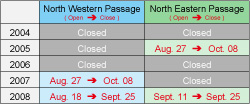
Table 1. Significant opening periods in past years of the North Western and North Eastern passages
Sea ice is continuing to melting throughout the arctic region, however both the North Western and North Eastern passages remain closed. The opening of the North Eastern passage is now only hindered by the sea ice that is present at the Taimyr peninsular (figure 1), although there has been no significant melting within this area over the past week suggesting that the North Eastern passage may remain closed for a while if current conditions continue.
Over the last decade both the Arctic passages have open and closed for short periods, but in 2005 the North Eastern passage (over Russia) opened for its longest time period in recorded history, that being over one month and opening the potential market for arctic shipping. After that the North Western passage (over Canada) open for the first time in 2007 while the North Eastern passage remained closed, although only staying open for a period of just over a week. On the 18th August 2008 the North Western passage opened again, this was then followed by an opening of the North Eastern passage although this passage only remained open for two weeks. The North Western passage then closed a few weeks later. 2008 marked the first time in recorded history when both passages opened simultaneously. Presently the only obstacle stopping the opening of the North Eastern passage is the sea ice at the Taimyr peninsular, However to forecast for such a region is extremely difficult due to the geometry of the area and small scale atmospheric influences, therefore it is suggested the observations are needed.
Sea Ice Extent
For this time of year, the sea ice extent for the Northern Hemisphere is recorded to be the third/fourth lowest ever recorded within historical records. The North Western/Eastern passages are also recorded to be the third/fourth lowest sea ice extent in recorded history. Figure 3. shows the extent of ice over the Arctic region, it can be clearly seen that the reduction in ice could possibility result in an opening of the Eastern passage in the next few weeks.
Sea Ice Conditions along Polar Routes
| NW Passage |
| Gulf of St.Lawrence |
Grand Banks |
Labrador Sea |
Davis Strait |
Baffin Bay |
Canadian Arctic E |
Canadian Arctic W |
Beaufort region |
Chukchi | Bering West |
| IF | IF | IF | IF | IF | IF | IF | IF | IF | |
| Greenland Sea SW |
Foxe Basin |
||||||||
| IF |
| NE Passage |
| Bering West |
Chukchi | East Siberian |
Laptev | Kara Sea N |
Barents Sea NE |
Barents Sea S |
Barents Sea NW |
| IF | IF | IF | IF | IF | |||
| Kara Sea S |
|||||||
| IF |
| Ice Concentration | Passage situation | |
| equal or more than 7 |
ships can not sail without icebreaker | |
| 4-6 | ice-strengthend ships can sail | |
| less than 3 | ice-worthy ships can sail | |
| IF | Ice Free | normal ships can sail |
Table 2. Sea ice extent for each region in the Arctic, showing the labelled colors to indicate navigable routes around the North Eastern and North Western passages.
Both Eastern and Western passages remain closed for the time being, although the rate of melting ice has declined over the past week throughout the arctic region. The Canadian Arctic West Sea ice continues to decline with all fast ice now having subsided, leaving areas with 7-10/10uh in its place. Reports have suggested that sea ice has declined within the Foxe Basin, making navigation for ice worthy vessels possible however sea ice concentration of 1-6/10uh still remain within this area making it inaccessible for normal vessels. The same can be seen within the North Eastern passage, satellite images have suggested that the passage continues to remain closed although slight reductions can be seen around the Eastern Siberian island of Novosibirskie and the other adjacent islands.
Model Prediction
Weathernews's I-SEE engine indicates that the reduction in sea ice with continue at a reduced rate from previously forecast. Within Laptev Sea and East Siberian Sea there will continue to be sea ice present resulting in the continuous closure of the Eastern route, although the sea ice will reduce in these areas from 10/10uh to just 6/10th.
Within the North Western passage there is expected to be a slight reduction of sea ice around the Canadian Arctic West, but an increase in sea ice in the Beaufort Sea this is due to sea ice movement rather than freezing, this area however will continue to remain predominately ice-free. The Global Forecasting model suggests that seasonal temperature will continue to range from 10-250C over much of Eastern Russia and 5-100C over much of the Western passage, indicating a continued trend of melting throughout the arctic region passage.
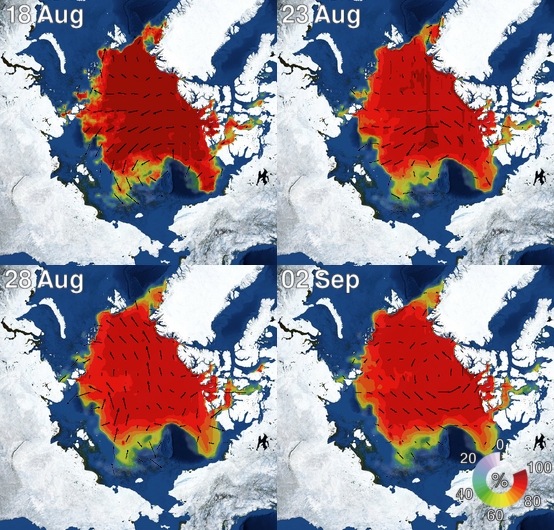
Figure 4. I-SEE engine, model predictions of the arctic sea ice


